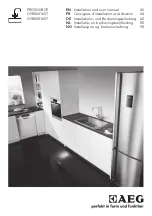
17
5.1 GAS SUPPLY INSTALLATION
Inspect the entire installation including the gas meter, test for
tightness and purge. Refer to BS 6891 (I.S. 813 in ROI) for
specific instruction.
5.2 THE HEATING SYSTEM
The appliance contains components that may become
damaged or rendered inoperable by oils and/or debris that
are residual from the installation of the system, consequently
it is essential that the system be flushed in accordance with
the following instructions.
5.3 INITIAL FILLING OF THE SYSTEM
Ensure both flow and return service valves are open, remove
appliance casing as described in 4.7.1, identify the automatic
air release valves (AAV) and loosen the dust cap/s by turning
the cap anti-clockwise one full turn. Ensure all manual air
release valves located on the heating system are closed.
Connect the filling loop as shown in fig. 5, slowly proceed to fill
the system by firstly opening the inlet valve connected to the
flow pipe, and then turning the lever on the fill valve, to the open
position. As water enters the system the pressure gauge will
begin to rise. Once the gauge has reached 1 BAR close both
valves and begin venting all manual air release valves, starting
at the lowest first. It may be necessary to go back and top-up the
pressure until the entire system has been filled. Inspect the
system for water tightness, rectifying any leaks.
5.3.1 MANUAL AIR RELEASE (fig. 19)
When the boiler has been filled for the first time or the system
has been drained and refilled, it will be necessary to release
any air that may have become trapped within the appliance
heat exchanger. Slacken the bleed screw until water is
released and then close.
IMPORTANT, THERE ARE NO OTHER MANUAL AIR
RELEASE VALVES LOCATED ON THE APPLIANCE.
5.4 INITIAL FLUSHING OF THE SYSTEM
The whole of the heating system must be flushed both cold and
hot as detailed in 5.8. Open all radiator or heating valves and
the appliance flow & return service valve. Drain the boiler and
system from the lowest points. Open the drain valve full bore to
remove any installation debris from the boiler prior to lighting.
Refill the boiler and heating system as described in 5.3.
5.5 PRE-OPERATION CHECKS
Before attempting the initial lighting of the appliance, the
following checks must be carried out:
•
ensure all gas service valves from the meter to the appliance
are open and the supply pipe has been properly purged;
•
ensure the proper electrical checks have been carried out,
Fig. 19
(see 7.8) particularly continuity, polarity and resistance to
earth;
•
ensure the 3 AMP fuse – supplied with the appliance – has
been fitted;
•
ensure the system has been filled, vented and the pressure
set to 1 BAR;
•
ensure the flue system has been fitted properly and in
accordance with the instructions;
•
ensure all appliance service valves are open.
5.6 INITIAL LIGHTING
Ensure the electrical supply to the appliance is switched on.
Ensure any external controls are switched to an ‘ON’ position
and are calling for heat. Move the selector switch to the ON
position, the appliance will now operate as described in 1.2.
Should the appliance fail to ignite, refer to 5.6 and/or section 7
(mode of operation, parameter setting & faultfinding).
5.7 CHECKING GAS PRESSURE AND COM-
BUSTION ANALYSIS
The appliance is factory set and requires no additional
adjustment once installed. However to satisfy the requirements
of GSIUR 26/9 (I.S. 813 ROI), it will be necessary to gas rate the
appliance using the gas meter that serves the appliance.
If the installation does not include a gas meter (for example
LPG) and there are no means by which to calculate the gas rate,
then a combustion analysis test must be carried out in
accordance with BS 7967 (UK) to ensure the appliance is left
working safely and correctly.
Additionally, if the gas valve has been adjusted, replaced, or
the appliance has been converted for use with another gas
type, then it becomes necessary to carry out a combustion
analysis/check to ensure that correct combustion is occurring.
If there are no means to gas rate the appliance and/or carry out
a combustion analysis check, then it will not be possible to
complete the commissioning procedure.
Details on how to carry out the combustion analysis can be
found in section 7.
IMPORTANT
It’s imperative that a sufficient dynamic – gas – pressure is
maintained at all times. Should the dynamic gas pressure fall
below an acceptable level, the appliance may malfunction or
sustain damage.
5.8 FINAL FLUSHING OF THE HEATING SYSTEM
The system shall be flushed in accordance with BS 7593 (I.S.
813 ROI). Should a cleanser be used, it must be suitable for
Aluminium heat exchangers. It shall be from a reputable manu-
facturer and shall be administered in strict accordance with
the manufacturers’ instructions and the DWTA code of practice.
NOTE
Chemicals used to cleanse the system and/or inhibit corrosion
must be pH neutral, i.e. they should ensure that the level of the
pH in the system water remains neutral. Premature failure of
certain components can occur if the level of pH in the system
water is out-with normal levels.
5.8.1 INHIBITORS
See Section 3 “General Requirements”.
5.9 SETTING THE FLOW OUTLET TEMPERA-
TURE
The flow outlet temperature can be adjusted between 40 °C - 80
°C for standard CH system by using the Heating thermostat knob
(see fig.1).
5.10 SETTING THE SYSTEM DESIGN
PRESSURE
The design pressure should be a minimum of 0.5 BAR and a
maximum of 1.5 BAR. The actual reading should ideally be 1
BAR plus the equivalent height in metres (0.1 BAR = 1 metre)
to the highest point in the system above the base of the
appliance (up to the maximum of 1.5 BAR total).
SECTION 5 - COMMISSIONING
















































